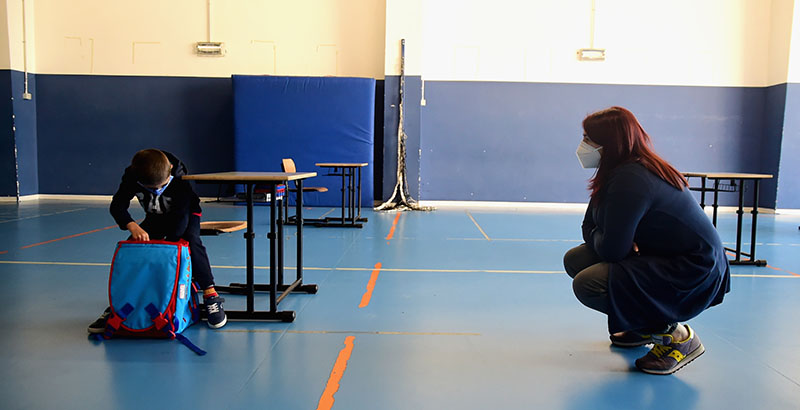Richmond & Cunningham: Reopening Schools Safely Brings Risks and Challenges. Here’s One Way Some Districts Could Get It Done

The traditional fall opening of school is about 16 weeks away, and no one yet knows whether schools will open, or how to keep students safe if they do and social distancing is still required. School systems, think tanks, teachers unions and others are offering thoughtful plans to open schools while containing the spread of the coronavirus, but they raise as many questions as answers.
Some districts are considering radically reducing class sizes to keep kids at least six feet apart. Whether that’s enough to prevent the spread of infection among young school kids who routinely touch each other, share food and play together is an open question, but the standard classroom size would pose a huge obstacle.
A typical classroom is 750 to 900 square feet. If each student requires a 6-by-6-foot space, that is 36 square feet per student. Add in a teacher’s desk, bookshelves and other classroom amenities, and class size would have to go down to about 15 students from the current average of about 23.
Here’s one idea for making this work. It wouldn’t apply everywhere but could make sense in some places: Keep high school students learning online until the virus is no longer a threat and use the empty high school classrooms for older K-8 students. There are a number of advantages.
First, students have already lost significant amounts of learning time. Smaller classes would give struggling students a better chance to catch up.
Second, providing full-time, on-site schooling for younger students would mean working parents could go back to their jobs. For the most part, older students can stay home alone. They also have more advanced computer skills and are better suited to online learning.
Third, the army of new teachers and classroom aides that would be required could provide employment for hundreds of thousands, if not millions, of people. Of course, that would lead to some serious challenges: finding and training school staffers in 16 weeks is not easy. But with 30 million recently unemployed and the Class of 2020 about to enter the job market, they exist.
Another obvious source of talent is recently retired teachers. However, they are in a high-risk category for infection, so their safest and best use might be to serve as virtual mentors for newly hired teachers. For a modest stipend, many might answer the call.
There are other challenges, of course, not the least of which is cost. Half a million or more additional employees in schools across the country could run into the hundreds of billions of dollars. Needless to say, it could happen only with a serious federal bailout, but schools will need that either way to avoid massive teacher layoffs next year.
Another challenge is the digital divide — with significant percentages of low-income and rural students lacking internet access or computers. School districts across the country are taking steps to close the gap with free or low-cost Wi-Fi and providing students with Chromebooks or laptops, but gross inequities remain.
And, of course, high school students are not known to be the most disciplined and self-directed sector of society. In order for this to work, parents, teachers and friends would need to build a robust culture of support and oversight. We need to do this anyway, but this crisis just makes it more urgent.
As with any plan, accommodations would have to be made. Some students with disabilities would still need face-to-face support. Most high school science programs still need lab time. Some districts might not need an entire high school and could keep ninth- and even 10th-graders on-site, albeit in smaller class groupings.
As the high school experience is, in so many ways, a social one — something that’s not to be undervalued — schools would need to develop supplemental activities for afternoons, evenings and weekends, where older students could safely convene.
And all schools would probably need extensive on-site quarantining. Among other things, they might want to conduct frequent temperature checks to identify and isolate infected students and staff.
Is all this ideal? No. Is it better than the alternative? Maybe. Would it work everywhere? Definitely not. Smaller districts and mom-and-pop charter schools would need to collaborate with partners or find other creative solutions, such as staggered schedules. But for many districts, it could be an option.
The bottom line is this: America must find a safe way to keep kids learning, and it’s pretty clear that an all-virtual system will not do the job for younger, more vulnerable students with working parents. Time to think outside the box.
Greg Richmond is chief officer for growth and strategy at Bluum and the founder of the National Association of Charter School Authorizers. Peter Cunningham is a communications consultant in Chicago and a former assistant secretary of education in the U.S. Department of Education.
Get stories like these delivered straight to your inbox. Sign up for The 74 Newsletter

;)
